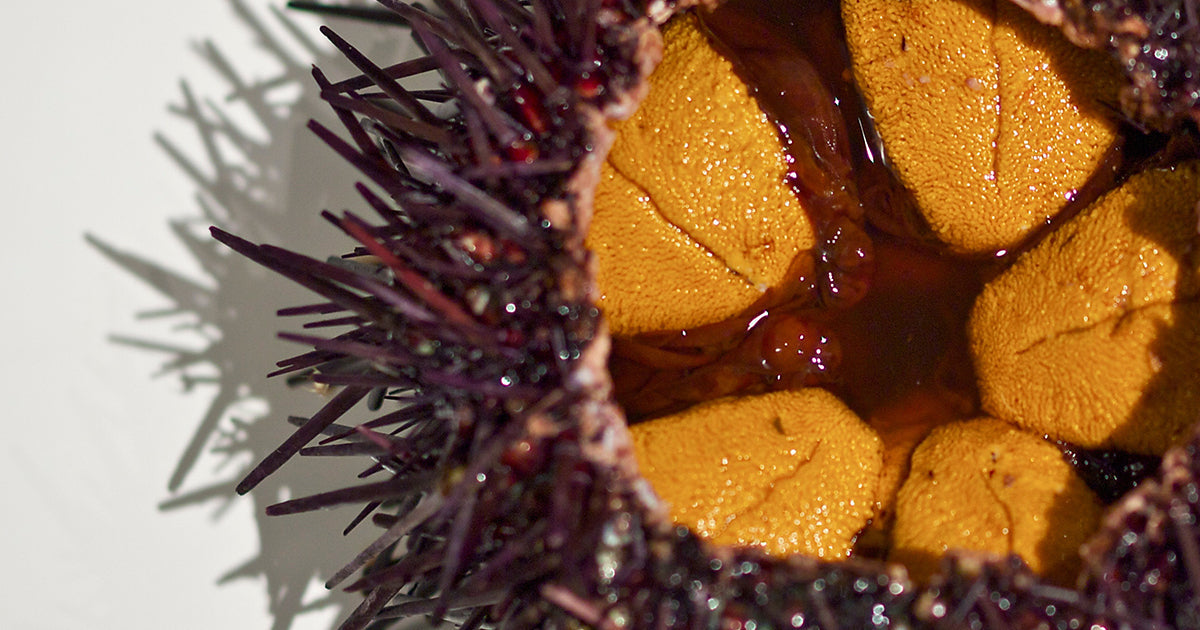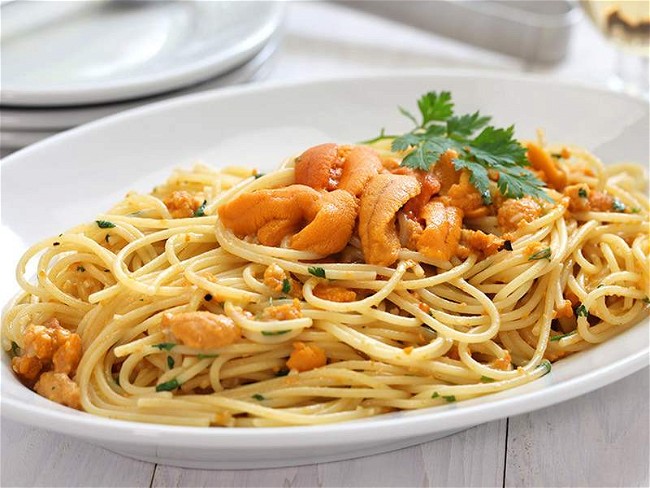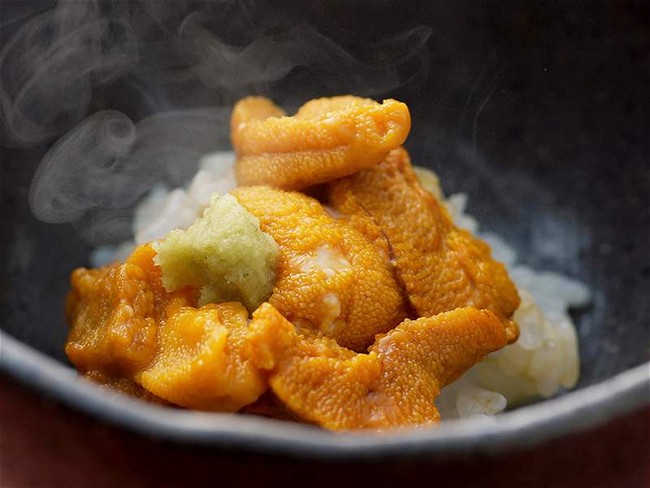Your Essential Guide to Uni

Sea urchins may not scream “delicious” from their notoriously spiny exteriors, but a taste of what’s inside could help you understand why these prehistoric invertebrates are treasured around the world. Uni, the common name for sea urchin’s reproductive organs, is prized for its unmistakably sweet yet briny flavor and creamy texture, delighting your eyes with gold color. Whether uni is used in southern Italian pasta sauces or Japanese sushi toppings, this beloved seafood is undoubtedly the star of its dish.
While Japan is responsible for over 80% of global uni consumption, the US has its own rich sea urchin history. Harvesting uni in the United States predates European colonization, with Native American tribes notably using sea urchins as a food source in the Pacific Northwest. Commercial uni fishing and farming in the United States ramped up in Maine in 1929, growing significantly since 1987 to meet demand from Japan’s restaurants and home cooks. The popularity of uni continues to grow exponentially as a staple in high-end restaurants and a sought-after ingredient for its unforgettable flavors.
Getting fresh uni to any kitchen, however, is a labor of love. From skillful cultivation and processing to their short shelf life, sea urchins require precision in their journey to your dinner table. Just ask 2nd-generation uni supplier, Millie Nagata.
“Our sea urchin is organic, minimally processed, and wild-caught in Santa Barbara, CA. The sea urchins are hand-harvested by our divers around the Channel Islands and transported directly to our plant in Vernon, CA, for processing. Once at the plant, the sea urchins are cracked open one at a time by hand, then the tender roe is carefully scooped out of the shell, and each piece of roe is cautiously washed in salt water by hand to remove any excess debris. Our specialized sea urchin packers carefully select the roe suitable for the appropriate grades, and each piece of roe is gently placed one by one in the tray. Once the trays are filled, they are ready for delivery.”
Hungry to learn more? Let’s dive into everything you need to know about uni.
- What Is Uni?
- What Does Uni Taste Like?
- What Are The Common Kinds of Sea Urchins?
- How Is Wild Uni Caught?
- How Is Sea Urchin Uni Graded?
- How Do I Eat Uni?
What Is Uni?
Uni typically refers to sea urchin roe. In the most proper form, however, uni is actually their gonads that produce roe. Nowadays, uni can commonly refer to just these reproductive organs or a whole urchin. Each sea urchin has five gonads, sometimes called “tongues” for their curved shape and tiny bumps that oddly resemble real tongues. Raw uni is usually neatly packed in wooden or plastic trays, and you may also see it sold whole as live urchins or, more rarely, packaged in a plastic container filled with saltwater to stay airtight.
What Does Uni Taste Like?
The taste of uni is often described as sweet and creamy, with a uniquely briny undertone that delights the palate. Some uni may also have increased umami (savory) or metallic flavor notes. The smooth texture melts in your mouth, making it a favorite among seafood enthusiasts. Uni should never taste or smell “fishy.” The flavors and textures of uni can vary significantly among the over 950 species of sea urchins. Factors such as the depth at which they are harvested, water temperature, and their food sources all contribute to these variations. The diversity in taste and texture is what makes uni such a fascinating and sought-after delicacy.
What Are The Common Kinds of Sea Urchins?
With over 950 species of sea urchins, the most commonly served varieties are often categorized by the color of their shells. When dining at a high-end restaurant, you're likely to encounter several distinct species, each offering unique characteristics. These species are widely consumed around the world and provide a unique taste experience, making them highly sought after in culinary circles. Here are the most common uni you may be lucky to indulge in:
- Red Sea Urchins: Red sea urchins, known as Aka uni, are the largest and most commonly found species in the US. Often reaching 5 to 7 inches in diameter, red sea urchins produce larger uni inside their shells, sometimes a couple of inches long, providing a more substantial bite. Red sea urchins are commonly found along the Pacific Coast of North America, from Alaska to Mexico, as well as in Patagonian regions like Chile. Red uni is prized for its vibrant gold hues and robust, rich flavor. The texture is firm yet creamy, making them a favorite in high-end culinary applications.
-
Green Sea Urchins: Green sea urchins, including Bafun uni, are typically small, ranging from 2 to 3 inches in size. The uni inside is also quite small, with a single piece of uni no larger than a thumbnail. Green uni can be found in the North Atlantic in the Gulf of Maine, arctic regions like Norway and Denmark, and Pacific regions from Japan to Russia. Green sea urchins are prized for their delicate, sweet flavor and smooth texture. Among green uni varieties, Bafun uni offers an intensely rich, creamy bite.
- Purple Sea Urchins: Purple sea urchins, referred to as Murasaki uni in Japan, are medium-sized urchins, typically ranging from 3 to 4 inches in diameter. Their shells have a deep purple color and their uni offers a brownish-gold color with a sweet, briny taste and custard-like creamy texture. Like their red sea urchin relatives, purple sea urchins are found along the Eastern Pacific Ocean. Among purple uni varieties, the flavor can vary slightly depending on their specific growing environment, but they are generally known for their delicate sweetness and smooth texture.
Where Is Uni Harvested?
Sea urchins are commercially harvested from various locations around the world, including California, the Gulf of Maine, the Pacific Northwest, Japan, Russia, Chile, Mexico, and Norway. These regions are known for their rich marine environments, which provide the ideal conditions for sea urchins to thrive.
When Is Uni In Season?
Wild sea urchin can be harvested year-round, with peak seasons from September to March, especially in northern fisheries like Maine and British Columbia. This period ensures the highest quality roe as uni is at their prime. Farmed sea urchins, on the other hand, are often harvested year-round.
How Is Wild Uni Caught?
Wild uni is typically harvested using methods that vary in their environmental impact. Divers often collect sea urchins by hand, a process known as raking or diving. This method allows for selective harvesting, ensuring only the best quality sea urchins are harvested while minimizing damage to marine ecosystems. In contrast, trawling involves dragging nets along the ocean floor to gather sea urchins. This method can disrupt the ocean floors and lead to unwanted bycatch. While trawling is efficient for large-scale operations, diving is preferred for its lower environmental impact and sustainability. Nagata explains, “Sustainable harvesting practices are crucial to preserving sea urchin populations and ensuring that future generations can enjoy uni."
Are Sea Urchins Farmed?
Urchin farming, known as echiniculture, involves cultivating sea urchins in controlled environments to ensure consistent quality and availability. There are two primary methods of farming uni: hatchery and ranching. In hatchery farming, sea urchins are bred and raised in ocean net pens, cages, or land-based tanks. This method allows for year-round harvesting and ensures the sea urchins are fed a diet that enhances their flavor and texture. Ranching involves collecting juvenile sea urchins from the wild and raising them in controlled environments until they reach maturity. Both methods aim to produce high-quality uni while minimizing the impact on natural sea urchin populations and their habitats.
What Do Sea Urchins Eat?
Sea urchins primarily feed on kelp, which is abundant in their natural habitats. They use their specialized mouthparts, known as Aristotle's lantern, to scrape and consume the kelp. This diet contributes to the unique umami flavor of uni roe. In controlled farming environments, sea urchins are often fed a special kelp diet designed to enhance their taste and texture.
How Is Sea Urchin Uni Graded?
Uni is graded by processors based on several factors, usually by color, firmness, and freshness. The grading system typically ranges from AA or A+ to C, with AA being the most premium. The grading process for sea urchin uni, similar to tuna, ensures a fair market value is given to urchins for their quality, with factors such as sourcing and the time from sea to processing playing crucial roles in determining the final grade.
- Grade AA or A+ uni, sometimes called premium uni, is extremely rare to come across, only graded in specific places, and is usually snapped up directly from Japanese restaurants and served just after harvest. Characterized by vibrant color, consistent size, and firmest texture, these uni may run up to thousands of dollars per pound.
- Grade A uni is considered the “sweet spot” for remarkable quality and accessibility. Grade A uni is very uniform in color, size, and firmness, offering unforgettable flavor and texture. Grade A uni has a bright yellow/gold color and is firm yet slightly giving, somewhat like flan, and has an oceanic sweetness. Fulton Fish Market is proud to offer exceptionally sourced Grade A uni to give chefs and home cooks the best opportunities to enjoy uni in its best form.
- Grade B or regular uni may have a less consistent color and softer texture than Grade A+ but is still suitable for various culinary uses from homemade sushi to sauces. Grade B uni appears a more muted yellow with a softer texture than Grade A and may contain some broken pieces.
- Grade C uni is darker, softer, and contains more broken pieces or “tongues” than Grade B or higher. This uni is most used for sauces and flavor enhancers rather than appearing whole on a plate.
How Do I Prepare Uni To Eat?
Uni is most commonly prepared raw or smoked. If you purchase uni on a tray, it is ready for you to prepare as you please. To prepare raw uni from a whole sea urchin, the first step is shucking the uni from the shell. You will want to carefully crack the shell open with a knife and spoon out the uni “tongues” into a bowl of cold saltwater to clean off any unwanted particles. Once the uni is cleaned, use a slotted spoon to place the uni on a strainer to release excess water before consuming.
Although raw uni is the most popular preparation, there is plenty to love about smoking it as well. Smoking uni provides a thorough cook while incorporating smoky flavors from your wood chips into the roe. We recommend a cold smoke for uni because it is extremely delicate. Without any brine or cure, try smoking the uni for about 30-45 minutes at 60-80°F (16-27°C). You can learn more about how to smoke seafood at home.
How Do I Eat Uni?
Uni can be treated quite similarly to caviar. You can easily enjoy uni right off the spoon or enhance your sea urchin experience by incorporating it into various dishes and preparations. Here are a few of our favorite uni recipes to consider:
Uni can be whisked into a creamy sauce to add a rich, briny flavor to a simple pasta. This recipe highlights uni’s simplicity in turning a simple dish into a stunning course while paying homage to southern Italian cuisine.
One of the most popular preparations for sea urchin is uni sushi, adding a burst of sweetness and creaminess to each bite.
If you’re not up for making uni sushi, you can enjoy a similar experience with a simple uni on rice, called “unidon.”
- Uni Toast: Top a slice of plain or lightly buttered toast with uni for a simple yet luxurious snack.
- Uni Bumps: For a unique twist, try "uni bumps." Place a small spoonful of uni on the back of your hand, typically below your thumb, and savor the flavors directly in one slurp—making for an indulgent taste sensation.
When enjoying uni without accompaniments, rest it on your tongue and gently press it against the roof of your mouth to let the uni melt away. Savoring uni slowly enhances the luxurious experience, similar to enjoying oysters or caviar.
FAQs
Is uni healthy?
Yes, uni is a nutritious delicacy that offers several health benefits. Sea urchin is rich in omega-3 fatty acids, which are essential for heart health and reducing inflammation. Uni is also a good source of protein, making it a valuable addition to a balanced diet. Additionally, uni contains high levels of vitamins and minerals, including vitamin A, vitamin E, and zinc, which support immune function, skin health, and overall well-being. The USDA notes that sea urchin roe is low in calories and fat, making it a healthy choice for those looking to enjoy a luxurious treat without compromising their dietary goals.
Why is sea urchin uni expensive?
Uni is considered a luxury delicacy and can be quite expensive for many reasons. The factors below are among the key reasons why sea urchins are such a luxury to eat:
- Sourcing Techniques: Sea urchins are often harvested from remote and pristine regions near Hokkaido, Japan, Santa Barbara, California, and Chile. Whether uni is harvested by divers, farmers, or boats, it takes significant logistics to safely cultivate the urchins and transport them for processing and shipping.
- Labor-Intensive Processing: Processing sea urchins is a meticulous and labor-intensive task that can only be done by hand. It involves manually cracking the shells, extracting the uni, washing, and removing contaminants with tweezers, then packaging the final product. This careful handling ensures the highest quality but also increases labor costs.
- Quality Grading: The quality of uni plays a critical role in its price. The grade is a universal indicator of quality, much like how gems are graded and valued. This is why you may see prized Grade AA uni fetch thousands of dollars per pound, whereas lower graded uni from the same species and regions sell for a fraction of the cost.
- Logistics and Short Shelf Life: Sea urchins have a very short shelf life out of water, typically lasting only a few days. The rapid transportation and expert storage needed to maintain uni’s freshness for consumption comes at a cost.
Is sea urchin uni sustainable?
The sustainability of uni depends on harvesting methods and population management, per NOAA’s Office of National Marine Sanctuaries. Sea urchins can overgraze kelp forests, creating "urchin barrens" where little marine life, including predators like sea otters, can thrive. This imbalance leads to uncontrolled urchin growth and poor-quality uni. However, completely removing sea urchins would disrupt the ecosystem by reducing the food supply for their predators.
Sustainable methods like diving or raking and farming allow for selective harvesting with minimal environmental impact, maintaining ecological balance. In contrast, trawling can sometimes disrupt marine habitats with damage to the sea floor or produce bycatch–the unintentional catch of other species. Farmed uni, produced through echiniculture, offers a sustainable alternative by reducing pressure on wild populations and ensuring year-round availability while also giving lower-quality urchins, like those found in urchin barrens, a chance to grow better and promote kelp forest growth. By choosing sustainable practices, we can enjoy uni while protecting marine habitats. Our sustainability practices at Fulton Fish Market ensure you won’t have to think twice about whether your uni is sourced sustainably. It’s our guarantee.
Are sea urchins poisonous?
Sea urchins commercially sold for food are not naturally poisonous. Uni is safe to eat when properly handled and is highly prized for its flavor and texture. To minimize the risk of foodborne illness, we recommend ordering uni from trusted sources that ensure proper handling and freshness.
While most sea urchins are not poisonous, some species, such as the flower urchin and the slate pencil urchin, can deliver painful stings. These species possess venomous spines and pedicellariae that can cause severe pain and allergic reactions if touched or stepped on. Of course, this should not be a concern when indulging in uni ordered from a reputable source.



